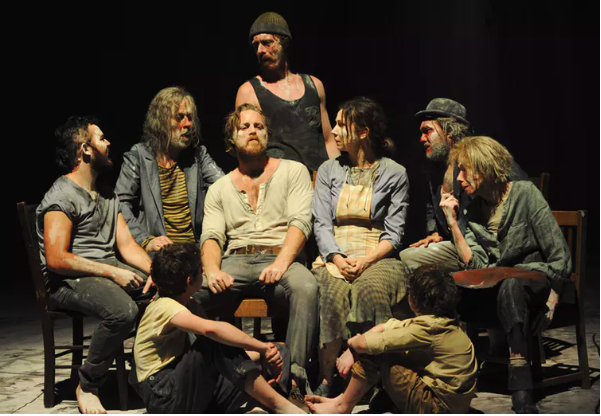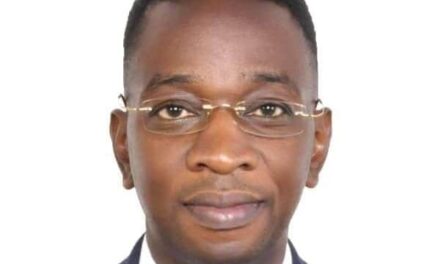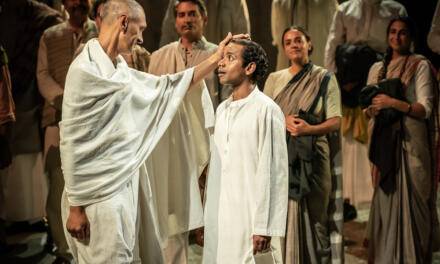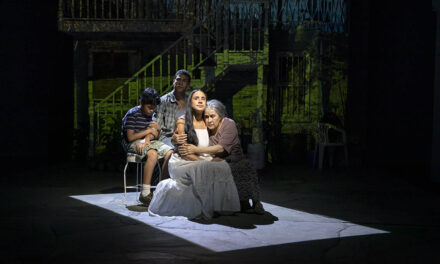Neil Armfield’s new stage adaptation of Kate Grenville’s 2005 novel The Secret River invites us to think about the complex relationships between personal and national histories, and the past and the present.
Grenville’s novel sparked controversy when it was published. The play reopens these contentious questions about who can tell the story of our shared history. Should it be historians or novelists, Indigenous or non-Indigenous storytellers?
Where historian Inga Clendinnen criticized Grenville for framing fiction as history, actress, and director Rachael Maza has recently challenged playwright Andrew Bovell’s representation of Aboriginal experience.
Grenville’s book began as research into her family history. She wanted to fill in the blanks of inherited stories about her ancestor, a pardoned convict who may have killed Aboriginal people during Australia’s settlement. But The Secret River always gestured to a wider story. It asks provocative questions about the silences in one family, but also in our nation’s history.
The title of the novel captures this double focus. It describes the river Grenville’s ancestors lived on, an inlet hidden by bush. But it also quotes from W. H. Stanner’s 1968 Boyer Lectures about the suppressed memory of colonial violence–“there is a secret river of blood in Australian history”.
Armfield wrote in a Sydney Theatre Company teacher resource, “The Secret River is a difficult story to tell” because “it leads relentlessly into dark places”. This was Grenville’s aim. She has argued,
Until we go back and retell our stories and put the shadows in we won’t grow up as a society.
Unpacking family histories can be a way to confront the past and understand our ancestor’s choices. But are we willing to accept that the stories we inherit may only be part of the picture? And are we prepared to listen to other people’s stories to hear the rest?
Family Silences
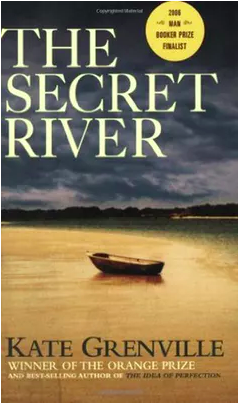
The Secret River, 2005. Canongate U.S.
When Grenville was a child, her mother, a keen keeper of the family’s tales, told stories about their ancestor Solomon Wiseman. Wiseman, the inspiration for The Secret River’s protagonist Will Thornhill, came to Sydney as a convict and eventually settled on the Hawkesbury River where he established a ferry-run and an inn.
Grenville’s mother spoke of Wiseman with pride and intrigue, believing her convict forebears had “shown a bit of spirit… in trying to get something for themselves and their families.”
For much of her life, Grenville did not question this family folklore. But walking across the Sydney Harbor Bridge for Reconciliation in the year 2000, she exchanges a glance with an Aboriginal woman and imagines their ancestors meeting 200 years before. Such encounters, Grenville reflects, were absent from the family stories. But surely Wiseman had met the Dharug people of the Hawkesbury region?
This event, Grenville writes in her memoir Searching for The Secret River (2006), prompted an exploration of her family past:
Now, for the first time, I wondered what had happened when Wiseman had arrived there and started the business of ‘settling’. Until this moment it had never occurred to me to wonder who might have been living on that land, and how he’d persuaded them to leave it.
Grenville set out on a mission to discover more about Wiseman and his story. What events were masked by terms like “settled” or “took up land”, which had, until now, seemed so innocent, repeated in family stories countless times?
Grenville wanted to understand Thornhill’s actions, and by proxy, the actions of many settlers. What drove him to take other people’s land? Did he feel guilty? Could he have been an otherwise good man who did a horrific thing?
The Ethics of Storytelling
Though it confronts hidden stories, The Secret River has been criticized for having its own blind spots. When the novel was first published, historians–most fervently Clendinnen, writing in Quarterly Essay–charged Grenville with conflating fiction and history, and excluding the voices of her Aboriginal characters.
In part, these debates boil down to a turf-war between history and historical fiction. But they also draw attention to ongoing anxieties about how non-Indigenous storytellers represent Aboriginal experiences. Do writers like Grenville have the right to speak on behalf of Indigenous peoples or to tell their stories? If not, should the Aboriginal characters in their novels remain without a voice? Both approaches present ethical problems.
This anxiety about representation troubled Grenville’s writing process. In her memoir Searching for The Secret River, Grenville says she wanted the Aboriginal characters to be as “fully alive, complex, and individual as the settlers”. To learn about the Indigenous experience she traveled to the Kimberley and listened to elders.
But upon returning to Sydney, Grenville decided to “get rid of all the Aboriginal dialogue”. “Their inside story – their responses, their thoughts, their feelings” she reasoned, “all that was for someone else to tell, someone who had the right to enter that world and the knowledge to do it properly”.
Adapting the novel for theatre, Andrew Bovell felt he could not make the same choice. Brought to life by a cast of both white and Aboriginal actors, the story was no longer just about the settlers’ vision. Bovell said at the end of 2015,
We simply couldn’t have silent black actors on stage being described from a distance. They needed a voice. They needed an attitude. They needed a point of view. They needed language…
Staging The Secret River
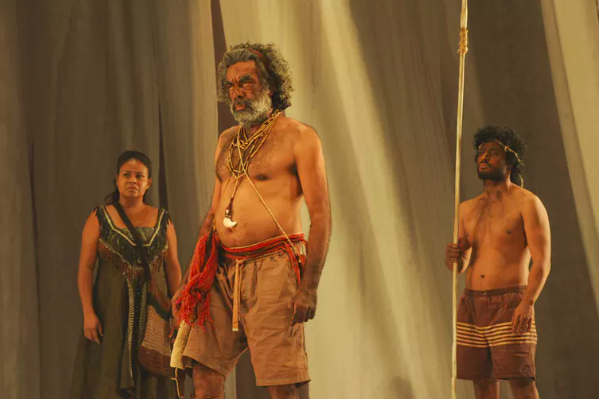
The Sydney Theatre Company/Heidrun Löhr
The play tries to remedy The Secret River’s limited perspective and moves towards telling a more inclusive national story. Grenville’s novel is a story about one family. Bovell’s adaptation is billed as the story of two: one English, one Dharug.
With multiple storytellers, the play represents history from different perspectives. The script still affords the Thornhills more dimension and dialogue, but the introduction of an Aboriginal narrator, the prophetic Dhirrumbin, unsettles the balance.
Similarly, in the novel, the Indigenous characters are known only by the nicknames that the Thornhills give them: Whisker Harry, Polly, and Meg. For Armfield’s production, actor and Dharug man Richard Green has given the characters Dharug names, language, and songs.
But not everyone is happy with the play. Even with these additions, Rachael Maza wrote last year, there is still a long way to go. Commenting on an earlier version, she said that the inclusion of Dharug language meant the Aboriginal characters had a voice but one she couldn’t access, which left her feeling closer to the Thornhills.
In response to the 2016 Melbourne season, Maza has criticised the ending of the play. She argues it perpetuates the myth that “the real Aboriginals died out”, rather than celebrating the “resilience and adaptation” of Indigenous groups.
Despite her reservations, Maza acknowledges that the play still tells an important story. It works to “find a way forward” in what is “going to be [an] awkward and… uncomfortable” effort to get the shared history of Indigenous and non-Indigenous Australians right.
Armfield has also spoken about the difficulty of telling a story that both “respectfully mourns the genocide that occurred across this land” and “celebrates the survival of Aboriginal culture against all forces”. Describing the play as a work in progress, he says “and so we keep searching to make it right”.
As the actors bowed on the stage of Art Centre Melbourne’s Playhouse it was clear they were unsteadied by the racism, violence, and suffering they had just performed. To see Nathaniel Dean (Thornhill) and Trevor Jamieson (Ngalamalum) hold to each other in recognition of their emotional sacrifice brought home the living politics of the story.
The audience was reminded that the repercussions of the frontier violence acted out in The Secret River are not just historical. As Armfield writes in his program note for the play: “Nine generations later, we are all living with its consequences”.
The Secret River gives us a deeper sense of our history. But as an audience we are also left with the question: can understanding the past from different perspectives help us confront the inequalities that linger in our present? The making of history, the play reminds us, is something that we live.
This article originally appeared on The Conversation on March 28, 2016, and has been reposted with permission.
This post was written by the author in their personal capacity.The opinions expressed in this article are the author’s own and do not reflect the view of The Theatre Times, their staff or collaborators.
This post was written by Ashley Barnwell.
The views expressed here belong to the author and do not necessarily reflect our views and opinions.

